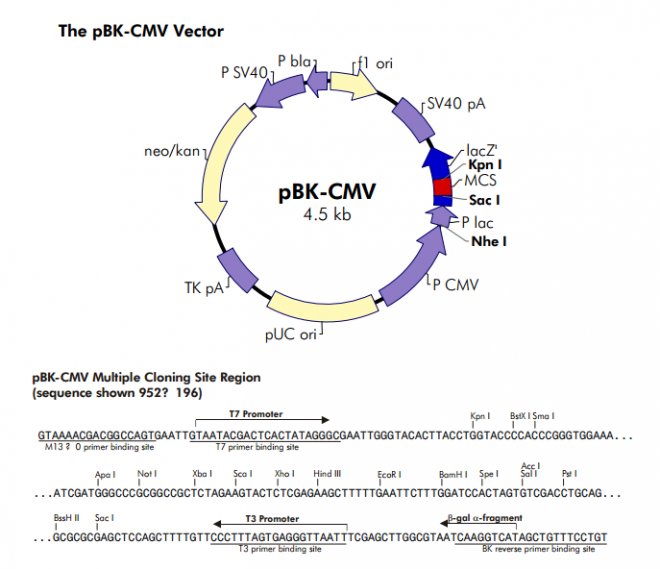pBK-CMV 载体
| 别名: | pBK CMV |
|---|---|
| 质粒类型: | 哺乳动物表达载体 |
| 表达水平: | 高拷贝 |
| 启动子: | CMV |
| 克隆方法: | 多克隆位点,限制性内切酶 |
| 载体大小: | 4518 bp (查看载体序列) |
| 5' 测序引物及序列: | T7 Fwd:5'd[TAATACGACTCACTATAGGG]3' |
| 载体抗性: | Kanamycin (卡那霉素) |
| 筛选标记: | 新霉素(Neo) |
The pBK-CMV phagemid vector1 is a cloning vector derived from a high-copy-number pUC-based plasmid. This vector allows expression in both eukaryotic and prokaryotic systems. Eukaryotic expression is driven by the cytomegalovirus (CMV) immediate early promoter in the pBK-CMV phagemid vector. Stable clone selection in eukaryotic cells is made possible with G418 by the presence of the neomycin- and kanamycin-resistance gene, which is driven by the SV40 early promoter with thymidine kinase (TK) transcription termination and polyadenylation signals.2 In the pBK-CMV phagemid vector, prokaryotic expression is driven by the lac promoter, which is repressed in the presence of the LacI protein and is inducible by IPTG. In bacteria expressing the lacZΔM15 mutation and lacI, colonies containing vector without insert will be blue in the presence of X-gal and IPTG. Kanamycin-resistant colonies containing vector with insert will be white and can express the inserted gene as a fusion protein.
Inserts should be cloned within the polylinker cloning sites for prokaryotic expression. For eukaryotic expression one can clone either within the polylinker or between the Nhe I site at the 5´ end of the lac promoter and a polylinker cloning site at the 3´ end (see Fig. 1). Removing the upstream lac sequences from the eukaryotic transcript by cloning between the Nhe I site and the polylinker sites has been shown to give elevated eukaryotic expression with test inserts.
The pBK–CMV phagemid vector has an extensive polylinker in an SK orientation (the Sac I site is the closest restriction site to the lacZ promoter, and the Kpn I site is the farthest restriction site from the lacZ promoter). The polylinker contains 17 unique restriction enzyme recognition sites, organized with alternating 5´ and 3´ overhangs to allow serial exonuclease III/mung bean nuclease deletions.2 Sites with compatible restriction overhangs, such as Spe I–Xba I and Sal I–Xho I, have been placed on opposite sides of the EcoR I site to allow unidirectional cloning in both the sense and antisense orientations with the ZAP Express vectors and the pBK– CMV phagemid vector. The (–) orientation of the f1 intergenic (IG) region in pBK-CMV allows rescue of antisense single-stranded DNA (ssDNA) relative to the lacZ transcript. This ssDNA can be used for dideoxynucleotide sequencing (Sanger method) or site-specific mutagenesis. Flanking the polylinker are T3 and T7 RNA polymerase promoters that can be used to synthesize RNA in vitro. The choice of promoter used to initiate transcription determines which strand of the DNA insert will be transcribed.


